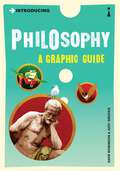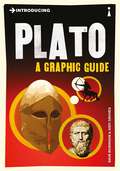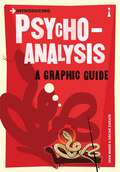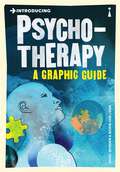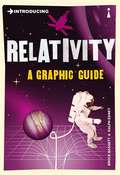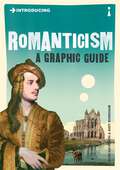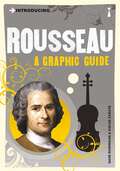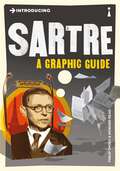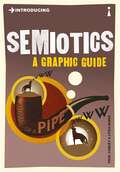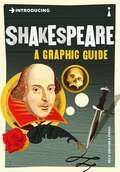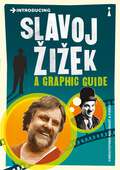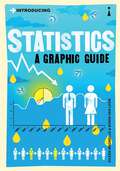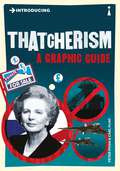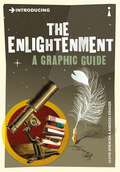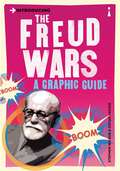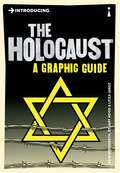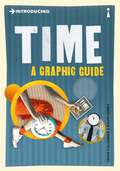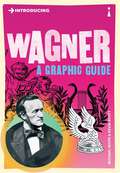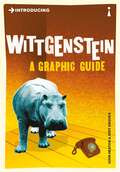- Table View
- List View
Introducing Nietzsche: A Graphic Guide (Introducing... #0)
by Laurence Gane PieroWhy must we believe that God is dead? Can we accept that traditional morality is just a 'useful mistake'? Did the principle of 'the will to power' lead to the Holocaust? What are the limitations of scientific knowledge? Is human evolution complete or only beginning? It is difficult to overestimate the importance of Friedrich Nietzsche for our present epoch. His extraordinary insights into human psychology, morality, religion and power seem quite clairvoyant today: existentialism, psychoanalysis, semiotics and postmodernism are plainly anticipated in his writings - which are famously enigmatic and often contradictory."Introducing Nietzsche" is the perfect guide to this exhilarating and oft-misunderstood philosopher.
Introducing Philosophy: A Graphic Guide (Introducing... #0)
by Dave Robinson Judy GrovesPhilosophers have always enjoyed asking awkward and provocative questions, such as: What is the nature of reality? What are human beings really like? What is special about the human mind and consciousness? Are we free to choose who we are and what we do? Can we prove that God exists? Can we be certain about anything at all? What is truth? Does language provide us with a true picture of the world? How should we behave towards each other? Do computers think? Introducing Philosophy is a comprehensive graphic guide to the thinking of all the significant philosophers of the Western world from Heraclitus to Derrida. It examines and explains their key arguments and ideas without being obscure or solemn. Lively and accessible, it is the perfect introduction to philosophers and philosophical ideas for anyone coming to the subject for the first time.
Introducing Philosophy of Science: A Graphic Guide (Introducing...)
by Ziauddin SardarWhat do scientists actually do? Is science "value-free"? How has science evolved through history? Where is science leading us? "Introducing Philosophy of Science" is a clear and incisively illustrated map of the big questions underpinning science. It is essential reading for students, the general public, and even scientists themselves.
Introducing Plato: A Graphic Guide (Introducing... #0)
by Dave Robinson"Introducing Plato" begins by explaining how philosophers like Socrates and Pythagoras influenced Plato's thought. It provides a clear account of Plato's puzzling theory of knowledge, and explains how this theory then directed his provocative views on politics, ethics and individual liberty. It offers detailed critical commentaries on all of the key doctrines of Platonism, especially the very odd theory of Forms, and concludes by revealing how Plato's philosophy stimulated the work of important modern thinkers such as Karl Popper, Martha Nussbaum, and Jacques Derrida.
Introducing Political Philosophy: A Graphic Guide (Introducing...)
by Dave RobinsonEssential illustrated guide to key ideas of political thought. Philosophers have always asked fundamental and disturbing questions about politics. Plato and Aristotle debated the merits of democracy. The origins of society, the state and government authority were issues addressed by Hobbes, Rousseau, Hegel, Marx and many other philosophers. Introducing Political Philosophy explains the central concepts of this intriguing branch of philosophy and presents the major political theorists from Plato to Foucault. How did governments get started? Why should they be obeyed? Could we live without them? How much power should they have? Is freedom a right? Which is the best form of government? In the wake of consumerism and postmodernism, our need for a better grasp of political ideas is greater than ever. Dave Robinson's account of this complex subject is always clear, informative and accompanied by the entertainingly inventive illustrations of Judy Groves.
Introducing Postmodernism: A Graphic Guide (Introducing...)
by Richard Appignanesi Chris GarrattWhat connects Marliyn Monroe, Disneyworld, "The Satanic Verses" and cyber space? Answer: Postmodernism. But what exactly is postmodernism? This graphic guide explains clearly the maddeningly enigmatic concept that has been used to define the world's cultural condition over the last three decades. "Introducing Postmodernism" tracks the idea back to its roots by taking a tour of some of the most extreme and exhilarating events, people and thought of the last 100 years: in art - constructivism, conceptual art, Marcel Duchamp, Jackson Pollock and Andy Warhol; in politics and history - McCarthy's witch-hunts, feminism, Francis Fukuyama and the Holocaust; in philosophy - the work of Derrida, Baudrillard, Foucault and Heidegger. The book also explores postmodernism's take on today, and the anxious grip of globalisation, unpredictable terrorism and unforeseen war that greeted the dawn of the 21st century. Regularly controversial, rarely straightforward and seldom easy, postmodernism is nonetheless a thrilling intellectual adventure. "Introducing Postmodernism" is the ideal guide.
Introducing Psychoanalysis: A Graphic Guide (Introducing... Ser.)
by Ivan WardThe ideas of psychoanalysis have permeated Western culture. It is the dominant paradigm through which we understand our emotional lives, and Freud still finds himself an iconic figure. Yet despite the constant stream of anti-Freud literature, little is known about contemporary psychoanalysis. Introducing Psychoanalysis redresses the balance. It introduces psychoanalysis as a unified 'theory of the unconscious' with a variety of different theoretical and therapeutic approaches, explains some of the strange ways in which psychoanalysts think about the mind, and is one of the few books to connect psychoanalysis to everyday life and common understanding of the world. How do psychoanalysts conceptualize the mind? Why was Freud so interested in sex? Is psychoanalysis a science? How does analysis work? In answering these questions, this book offers new insights into the nature of psychoanalytic theory and original ways of describing therapeutic practice. The theory comes alive through Oscar Zarate's insightful and daring illustrations, which enlighten the text. In demystifying and explaining psychoanalysis, this book will be of interest to students, teachers and the general public.
Introducing Psychology: A Graphic Guide (Introducing...)
by Nigel BensonWhat is psychology? When did it begin? Where did it come from? How does psychology compare with related subjects such as psychiatry and psychotherapy? To what extent is it scientific? Introducing Psychology answers all these questions and more, explaining what the subject has been in the past and what it is now. The main "schools" of thought and the sections within psychology are described, including Introspection, Biopsychology, Psychoanalysis, Behaviourism, Comparative (Animal) Psychology, Cognitive Approaches (including the Gestalt movement), Social Psychology, Developmental Psychology and Humanism. The key figures covered include: Freud, Pavlov, Skinner, Bandura, Piaget, Bowlby, Maslow and Rogers, as well as many lesser-known but important psychologists.
Introducing Psychotherapy: A Graphic Guide (Introducing...)
by Nigel BensonWhat is psychotherapy? How can we choose wisely from so much on offer?This book provides a valuable summary of the main therapies: the "talking cures" of psychoanalysis, behavioral and cognitive techniques, somatic solutions, humanist gestalt and existential approaches, and individual and group therapies.
Introducing Quantum Theory: A Graphic Guide (Introducing...)
by J.P. McEvoy Oscar ZarateQuantum theory confronts us with bizarre paradoxes which contradict the logic of classical physics. At the subatomic level, one particle seems to know what the others are doing, and according to Heisenberg's "uncertainty principle", there is a limit on how accurately nature can be observed. And yet the theory is amazingly accurate and widely applied, explaining all of chemistry and most of physics. Introducing Quantum Theory takes us on a step-by-step tour with the key figures, including Planck, Einstein, Bohr, Heisenberg and Schrodinger. Each contributed at least one crucial concept to the theory. The puzzle of the wave-particle duality is here, along with descriptions of the two questions raised against Bohr's "Copenhagen Interpretation" - the famous "dead and alive cat" and the EPR paradox. Both remain unresolved.
Introducing Relativity: A Graphic Guide (Introducing...)
by Bruce BassettIt is now more than a century since Einstein's theories of Special and General Relativity began to revolutionise our view of the universe. Beginning near the speed of light and proceeding to explorations of space-time and curved spaces, "Introducing Relativity" plots a visually accessible course through the thought experiments that have given shape to contemporary physics. Scientists from Newton to Hawking add their unique contributions to this story, as we encounter Einstein's astounding vision of gravity as the curvature of space-time and arrive at the breathtakingly beautiful field equations. Einstein's legacy is reviewed in the most advanced frontiers of physics today - black holes, gravitational waves, the accelerating universe and string theory. This is a superlative, fascinating graphic account of Einstein's strange world and how his legacy has been built upon since.
Introducing Romanticism: A Graphic Guide (Introducing...)
by Duncan HeathPhilosophy, art, literature, music, and politics were all transformed in the turbulent period between the French Revolution of 1789 and the Communist Manifesto of 1848. This was the age of the 'Romantic revolution', when modern attitudes to political and artistic freedom were born. When we think of Romanticism, flamboyant figures such as Byron or Shelley instantly spring to mind, but what about Napoleon or Hegel, Turner or Blake, Wagner or Marx? How was it that Romanticism could give birth to passionate individualism and chauvinistic nationalism at the same time? How did it prefigure the totalitarian movements of the 20th century? Duncan Heath and Judy Boreham answer these questions and provide a unique overview of the many interlocking strands of Romanticism, focusing on the leading figures in Britain, Germany, France, Italy, Russia and America.
Introducing Rousseau: A Graphic Guide (Introducing...)
by Dave RobinsonIllustrated guide to the crucial French philosopher who denied bring a philosopher at all. 'I am like no one else in the whole world ...' Thus begins Jean-Jacques Rousseau's defiant Confessions - an autobiography of astounding psychological insight. Musician, poet, novelist and botanist, but above all, a philosopher who firmly denied being one, Rousseau was the first to ask: "What is the value of civilization?" His answer - that civilization corrupts natural goodness and increases social inequalities - shocked his Enlightenment contemporaries and still challenges us today. Did Rousseau inspire the French Revolution? Can Romanticism, psychoanalysis and Existentialism all be traced back to him? Introducing Rousseau presents a maverick thinker whose ideas revolutionized our understanding of childhood, education, government, language and much else. Dave Robinson's clear and concise account of Rousseau's ideas, engagingly dramatized by Oscar Zarate's illustrations, guides the reader through Rousseau's turbulent life of lost innocence, persecution and paranoia.
Introducing Sartre: A Graphic Guide (Introducing...)
by Philip ThodyINTRODUCING guide to the father of existentialism and one of 20th century philosophy's most famous characters. Jean-Paul Sartre was once described as being, next to Charles de Gaulle, the most famous Frenchman of the 20th century. Between the ending of the Second World War in 1945 and his death in 1980, Sartre was certainly the most famous French writer, as well as one of the best-known living philosophers. Introducing Sartre explains the basic ideas inspiring his world view, and pays particular attention to his idea of freedom. It also places his thinking on literature in the context of the 20th century debate on its nature and function. It examines his ideas on Marxism, his enthusiasm for the student rebellion of 1968, and his support for movements of national liberation in the Third World. The book also provides a succinct account of his life, and especially of the impact which his unusual childhood had on his attitude towards French society.
Introducing Semiotics: A Graphic Guide (Introducing... #18)
by Paul Cobley"Introducing Semiotics" outlines the development of sign study from its classical precursors to contemporary post-structuralism. Through Paul Cobley's incisive text and Litza Jansz's brilliant illustrations, it identifies the key semioticians and their work and explains the simple concepts behind difficult terms. For anybody who wishes to know why signs are crucial to human existence and how we can begin to study systems of signification, this book is the place to start.
Introducing Shakespeare: A Graphic Guide (Introducing... Ser.)
by Nick GroomShakespeare's absolute pre-eminence is simply unparalleled. His plays pack theatres and provide Hollywood with block-buster scripts; his works inspire mountains of scholarship and criticism every year. He has given us many of the very words we speak, and even some of the thoughts we think. Nick Groom and Piero explore how Shakespeare became so famous and influential, and why he is still widely considered the greatest writer ever. They investigate how the Bard has been worshipped at different times and in different places, used and abused to cultural and political ends, and the roots of intense controversies which have surrounded his work. Much more than a biography or a guide to his plays and sonnets, Introducing Shakespeare is a tour through the world of Will and concludes that even after centuries, Shakespeare remains the battlefield on which our very comprehension of humanity is being fought out.
Introducing Slavoj Zizek: A Graphic Guide (Introducing... Ser. #0)
by Christopher Kul-WantCharting his meteoric rise in popularity, Christopher Kul-Want and Piero explore Zizek's timely analyses of today's global crises concerning ecology, mounting poverty, war, civil unrest and revolution. Covering topics from philosophy and ethics, politics and ideology, religion and art, to literature, cinema, corporate marketing, quantum physics and virtual reality, Introducing Slavoj Zizek deftly explains Zizek's virtuoso ability to transform apparently outworn ideologies – Communism, Marxism and psychoanalysis – into a new theory of freedom and enjoyment.
Introducing Statistics: A Graphic Guide (Introducing... #67)
by Eileen MagnelloFrom the medicine we take, the treatments we receive, the aptitude and psychometric tests given by employers, the cars we drive, the clothes we wear to even the beer we drink, statistics have given shape to the world we inhabit. For the media, statistics are routinely 'damning', 'horrifying', or, occasionally, 'encouraging'. Yet, for all their ubiquity, most of us really don't know what to make of statistics. Exploring the history, mathematics, philosophy and practical use of statistics, Eileen Magnello - accompanied by Bill Mayblin's intelligent graphic illustration - traces the rise of statistics from the ancient Babylonians, Egyptians and Chinese, to the censuses of Romans and the Greeks, and the modern emergence of the term itself in Europe. She explores the 'vital statistics' of, in particular, William Farr, and the mathematical statistics of Karl Pearson and R.A. Fisher.She even tells how knowledge of statistics can prolong one's life, as it did for evolutionary biologist Stephen Jay Gould, given eight months to live after a cancer diagnoses in 1982 - and he lived until 2002. This title offers an enjoyable, surprise-filled tour through a subject that is both fascinating and crucial to understanding our world.
Introducing Thatcherism: A Graphic Guide (Introducing...)
by Peter PughMargaret Thatcher's political career was one of the most remarkable of modern times. She rose to become the first woman to lead a major Western democracy, serving as British Prime Minister. Admired by Ronald Regan and the United States Congress, "Introducing Thatcherism" looks at the political philosophy behind this influential and controversial woman.
Introducing the Enlightenment: A Graphic Guide (Introducing...)
by Lloyd Spencer"Introducing The Enlightenment" is the essential guide to the giants of the Enlightenment - Voltaire, Diderot, Adam Smith, Samuel Johnson, Immanuel Kant, Benjamin Franklin, and Thomas Jefferson. The Enlightenment of the 18th century was a crucial time in human history - a vast moral, scientific and political movement, the work of intellectuals across Europe and the New World, who began to free themselves from despotism, bigotry and superstition and tried to change the world. "Introducing The Enlightenment" is a clear and accessible introduction to the leading thinkers of the age, the men and women who believed that rational endeavour could reveal the secrets of the universe.
Introducing the Freud Wars: A Graphic Guide (Introducing...)
by Stephen WilsonCompact INTRODUCING guide on the debates surrounding psychoanalysis's most contested figure. Freud is universally recognised as a pivotal figure in modern culture. Yet the man and his work continually attract scandal, outrage and scientific suspicion. Was he a psychological genius or a peddler of humbug? Despite his atheism, did he invent a new religious cult? Is he to blame for disguising the prevalence of sexual abuse? Is there an Oedipus Complex? Was he a drug addict? A wittily illustrated glimpse behind the demonised myths to the heart of a red-hot debate.
Introducing the Holocaust: A Graphic Guide (Introducing...)
by Stuart Hood Litza Jansz Haim Bresheeth'Excellent ... an astounding amount of material.' Times Educational Supplement Popular culture often portrays the Holocaust as a horrific drama played out between Nazi executioners and ghetto Jewish victims - in short, a single aberration of history. Introducing the Holocaust is a powerful graphic guide that dissolves this stereotype, explaining the causes and its relevance today. It places the Holocaust where it belongs - at the centre of modern European and world history. Haim Bresheeth and Stuart Hood - along with Litza Jansz's outstanding illustrations - bring a unique and unforgettable perspective to how we think about this most dark of shadows on human history.
Introducing Time: A Graphic Guide (Introducing... #50)
by Craig CallenderWhat is time? The 5th-century philosopher St Augustine famously said that he knew what time was, so long as no one asked him. Is time a fourth dimension similar to space or does it flow in some sense? And if it flows, does it make sense to say how fast? Does the future exist? Is time travel possible? Why does time seem to pass in only one direction?These questions and others are among the deepest and most subtle that one can ask, but "Introducing Time" presents them - many for the first time - in an easily accessible, lucid and engaging manner, wittily illustrated by Ralph Edney.
Introducing Wagner: A Graphic Guide (Introducing...)
by Michael White Kevin ScottWagner's operatic works rank with the supreme achievements of western culture. But acceptance of Wagner's musical genius is tempered by feelings of misgiving and many believe the composer's underlying ideas to be indefensible. A self-styled social revolutionary, Wagner thought the world could be redeemed through vegetarianism and Aryan philosophy. Introducing Wagner: A Graphic Guide separates the composer's art from the ideas and the arrogant destructive personal behaviour of the man.
Introducing Wittgenstein: A Graphic Guide (Introducing...)
by John HeatonThis is a superlative graphic guide described as 'warm, witty and wise' by Jonathan Ree to an enigmatic master of twentieth-century philosophy.

